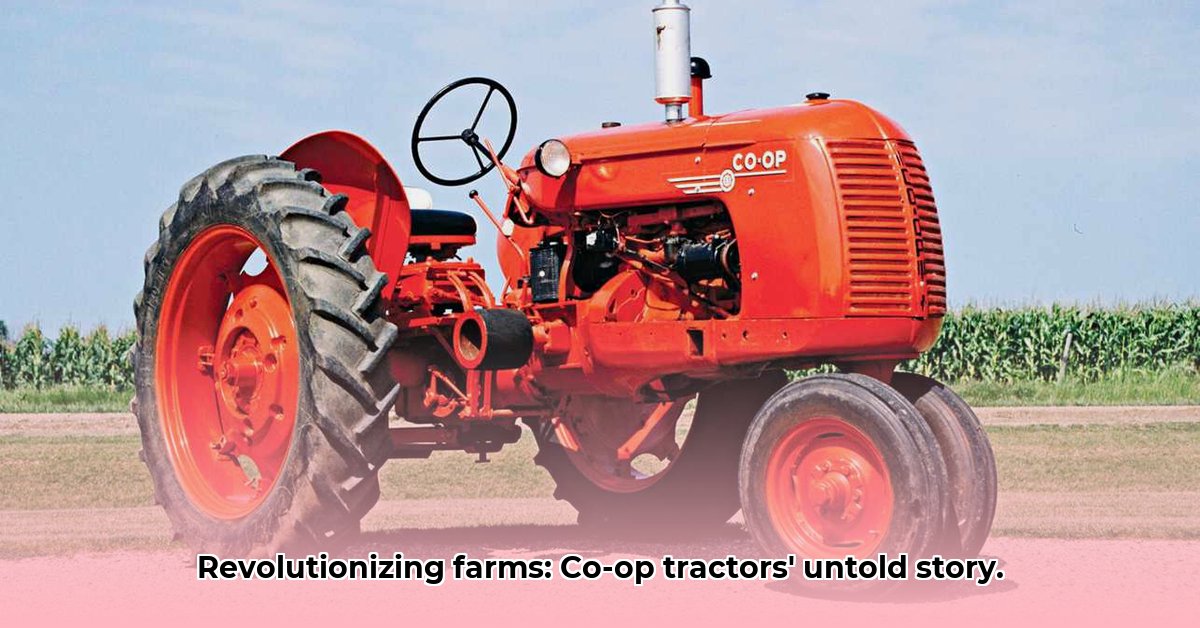
The dust bowl years of the Great Depression left American farmers battered and struggling. Many couldn't afford the expensive new farm machinery that promised increased efficiency, leaving them behind in a rapidly changing agricultural landscape. But out of this hardship arose a radical idea: farmers pooling resources to build their own tractors. This was the improbable genesis of the Co-op tractor, a story of community-driven ingenuity, surprising partnerships, and a hard-fought battle against industry giants. It's a tale that offers enduring lessons for anyone interested in agricultural history, cooperative economics, or the complexities of disruptive innovation. For another example of innovative farm machinery, see Ford N-Series tractors.
A Community's Ingenuity: Building the Dream
The core concept was simple yet revolutionary: collective action could level the playing field. It wasn't just a business venture; it was a movement fueled by shared hardship and the fervent belief in self-reliance. Early Co-op tractors weren't sleek and modern; they were robust workhorses, prioritizing functionality over flash.
A pivotal strategic decision was the partnership with Chrysler. Leveraging readily available automotive parts and engines was incredibly cost-effective; it avoided the need to reinvent the wheel (or the engine). This allowed the Co-op to concentrate its resources on the tractor's unique features. Production began in Michigan, likely due to its access to components and a skilled workforce. The operation later expanded to Shelbyville, Indiana, possibly to better serve a broader geographic market.
However, collaboration with other manufacturers, such as Cletrac and Cockshutt, also introduced complexities. While these partnerships offered potential economies of scale and access to specialized expertise, the coordination needed to align production schedules, quality control, and design between different companies was a significant challenge.
A David and Goliath Story: Success and Setbacks
The Co-op tractor initially found considerable success. Farmers experienced immediate cost savings, improving their bottom lines and empowering them with greater autonomy over their operations. This early triumph was a powerful demonstration of what could be achieved through collective effort. It seemed, for a time, that the cooperative business model had struck gold.
But the agricultural machinery industry was a heavily entrenched oligopoly, dominated by giants like John Deere and International Harvester. These established companies possessed vastly superior resources—substantial marketing budgets, expansive distribution networks, and significantly larger research and development capabilities. The Co-op, despite its effectiveness, simply couldn't match the scale and marketing prowess of these behemoths.
The Co-op's relatively small production volume also proved a major limitation. It lacked the economies of scale to compete with the lower prices offered by larger manufacturers. Furthermore, despite its quality, the Co-op tractor never achieved comparable brand recognition. Its niche market status severely constrained its potential for growth. Ultimately, the Co-op was absorbed by Cockshutt, marking the end of this ambitious experiment.
Lessons from the Field: A Case Study in Collaboration
The Co-op tractor's journey provides invaluable lessons for anyone contemplating collaborative ventures, particularly in capital-intensive industries like agriculture. The initial cost savings demonstrated the power of collective action. But the experience also starkly highlighted the difficulties facing smaller organizations competing with well-established players.
"The Co-op’s failure underscores the importance of not only collaboration, but also a strong marketing strategy and effective branding in a competitive landscape," states Dr. Eleanor Vance, Professor of Agricultural Economics at Cornell University. "While the cost savings were significant, they weren't enough to offset the marketing and distribution advantages of larger firms."
The reliance on external manufacturing partnerships, while initially beneficial, introduced complexities that hindered the Co-op's agility and control. This emphasizes the critical importance of clear organizational structure and robust communication among partners. Ongoing research in collaborative agriculture continues to explore lessons learned from this case study.
SWOT Analysis of the Co-op Tractor Venture:
| Stakeholder | Strengths | Weaknesses | Opportunities | Threats |
|---|---|---|---|---|
| Co-op Farmers | Reduced costs; increased autonomy; shared risk and benefits | Limited scale; lack of marketing and distribution expertise | Niche markets; specialized equipment development | Intense competition; economic downturns; regulatory hurdles |
| Manufacturing Partners | Access to new markets; technology sharing; shared resources | Potential coordination problems; risk associated with co-ops | Diversification; exploring new cooperative business models | Market volatility; technological advancements; shifting demand |
Enduring Legacy: More Than Just a Tractor
Although the Co-op tractor ultimately failed to disrupt the agricultural machinery industry, its story remains a compelling narrative of ingenuity, community, and the persistent striving for economic self-determination. Its eventual decline doesn't diminish its significance. It serves as a valuable case study, providing critical insights into cooperative ventures, the challenges of competing in established markets, and the crucial role of a strong brand identity. More broadly, it highlights the resourceful spirit of farmers and their relentless pursuit of innovation. The Co-op tractor’s legacy is not just about a machine; it’s a testament to the enduring power of collective action.
How Did Co-op Tractor Production Numbers Compare to Competitors in the 1940s?
Precise production data for Co-op tractors is difficult to obtain. Records are incomplete and inconsistent. Available sources suggest production was vastly smaller than that of industry giants like John Deere or International Harvester. The Co-op's production involved multiple partnerships and smaller-scale operations, and exact numbers remain elusive, making direct comparisons challenging, but highlighting the reality of their significant production disadvantage. The fragmented records of the Co-op's production highlight a critical vulnerability: lack of scale in a capital-intensive industry.
Key Takeaways:
- The Co-op tractor represents a significant, though ultimately unsuccessful, experiment in cooperative agricultural mechanization.
- Limited production volumes, relative to established manufacturers, significantly hampered its market success.
- Future cooperative agricultural ventures can benefit from the Co-op’s experience by focusing on strategic alliances, increased production capacity, and robust branding.